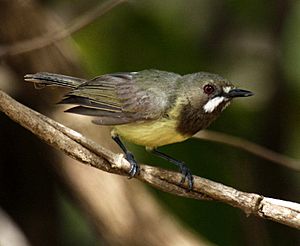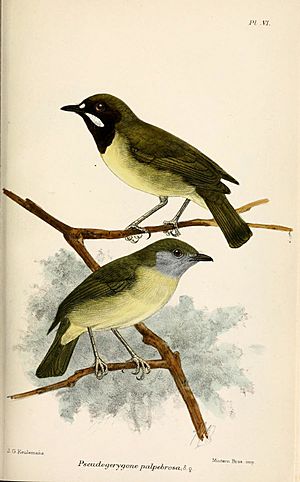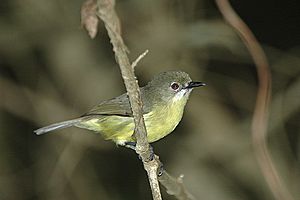Fairy gerygone facts for kids
Quick facts for kids Fairy gerygone |
|
|---|---|
 |
|
| Conservation status | |
| Scientific classification | |
| Genus: |
Gerygone
|
| Species: |
palpebrosa
|
| Synonyms | |
|
|
The fairy gerygone (Gerygone palpebrosa) is a small, colorful bird. It lives in New Guinea and Queensland, Australia. This bird belongs to a family called Acanthizidae. It was once known as the fairy warbler.
Contents
Discovering the Fairy Gerygone
Who Named the Fairy Gerygone?
A famous scientist named Alfred Russel Wallace first described the fairy gerygone in 1865. He found a bird specimen in the Aru Islands. The name palpebrosa comes from a Latin word. It means "eyelid," which refers to the special markings around the bird's eyes.
One Species, Many Names
For a while, another bird called the fairy warbler (Gerygone flavida) was thought to be a different species. This bird was found near the Herbert River in Queensland. However, scientists noticed that birds living further north along the Queensland coast looked more and more like the Gerygone palpebrosa. Their songs were also very similar. This showed that they were actually the same species.
People used to call these birds by many names. Some names included black-throated or masked gerygone. Others called them warbler or flyeater. Some even called them "hornet-nest birds." This was because they often built their nests close to wasp nests!
Family Tree of the Fairy Gerygone
Scientists have studied the genes of these birds. They found that the fairy gerygone is most closely related to the green-backed gerygone (Gerygone chloronota). Their ancestors separated about two million years ago.
Different Types of Fairy Gerygones
There are six recognized types, or subspecies, of the fairy gerygone:
- G. p. palpebrosa: Found in southwestern New Guinea and the Aru Islands.
- G. p. wahnesi: Lives in northern New Guinea and Wapen Island.
- G. p. inconspicua: Found in southeastern New Guinea.
- G. p. tarara: Lives in southern New Guinea.
- G. p. personata: Found in north Queensland, Australia (Cape York Peninsula).
- G. p. flavida: Lives in central Queensland, Australia.
What Does the Fairy Gerygone Look Like?
Adult fairy gerygones have olive-colored feathers on their backs. Their undersides are bright yellow. They have brownish tails and short black beaks and legs. Their eyes are a striking red color.
Male fairy gerygones have a black throat. This helps you tell them apart from the females. One subspecies, flavida, has a white tip on its tail. This helps to tell it apart from the personata subspecies.
Where Do Fairy Gerygones Live?
You can find the fairy gerygone in Australia, Indonesia, and Papua New Guinea. These birds like to live in certain places. Their favorite homes are warm, wet lowland forests. They also enjoy living in tropical mangrove forests.
The IUCN lists the fairy gerygone as a species of Least Concern. This means that scientists are not worried about them disappearing. There are many of these birds, and their population is stable.
Fairy Gerygone Behaviour
Singing in Danger
Male fairy gerygones stand up tall and sing a loud, beautiful song. They do this when they hear predators, especially the black butcherbird. The black butcherbird is one of their main enemies. Scientists are not completely sure why they sing when there is danger. It might be a way for the male to show off to female birds. It could mean he is brave and can sing well even when things are risky.
Nesting Near Wasps
The fairy gerygone often builds its nest near wasp nests. This might seem strange, but it could be a clever way to stay safe. The wasps might help protect the bird's nest from other predators.
See also
 In Spanish: Gerygone palpebrosa para niños
In Spanish: Gerygone palpebrosa para niños




